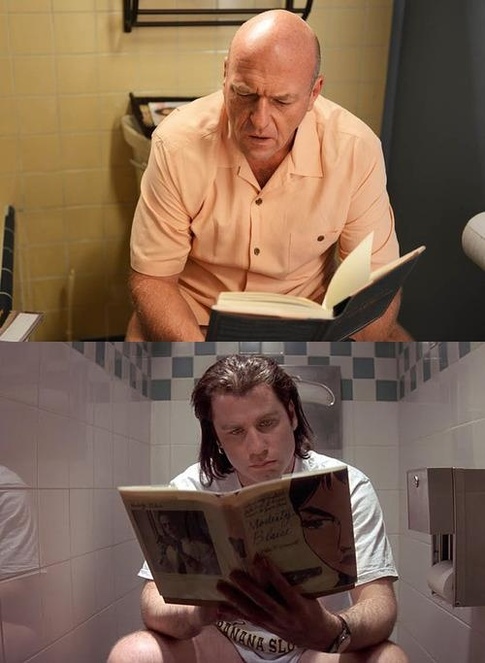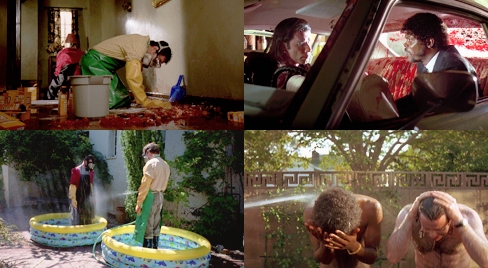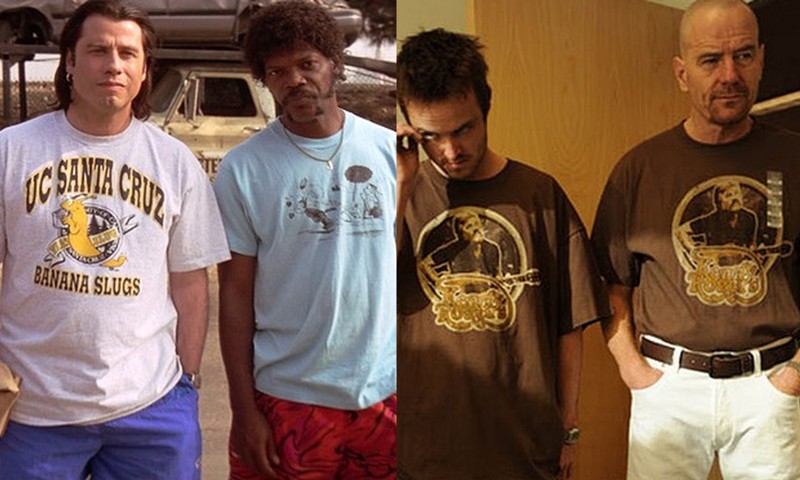
They both are cult opuses. They both inspired a generation of movie-going and Television-viewing populace. They both are unforgettable works of fiction that unreservedly revolutionized the face of contemporary cinematic trends. If Breaking Bad is hailed as one of the most historic TV series of all time, Pulp Fiction is also righteously considered as the pioneer of modern black comedy crime movies.
There’s no doubting that both list as our favorites but a closer pondering and you will realize that the visual and thematic similarities between director Quentin Tarantino’s Pulp Fiction and Vince Gilligan’s “Breaking Bad” are too abundant to go unnoticed. From scenes to sequences, framing, shots and angles- Breaking Bad has prudently pulled numerous Pulp Fiction references that only adds up to the already escalated brilliance of the show. Both are cornerstoned on near-identical premises of humor and violence, the southern American crime world, drug cartels, non-linear narratives and visual metaphors. However, the extended correlations do not certainly end there.
As September 2014 marks the 20th Anniversary of Pulp Fiction and also one year since Breaking Bad went off air, here’s a telescopic look of the 10 prominent visual parallels that Breaking Bad share with Pulp Fiction.
Also Read: The Good, the Bad and the Walter
To begin from the scratch, recall the pilot of Breaking Bad where “all things bad” broke out for the inaugural time. The scene where protagonist Walter White (played by Bryan Cranston) steps on the roadway holding a gun in his hand for the first time in his life and aiming it to an approaching vehicle bears a stringing resemblance to the scene in Pulp Fiction where Butch (played by Bruce Willis) holds the machine gun from the kitchen counter of his apartment and aims toward a startled Vincent Vega (John Travolta) before firing him to death. A hint of conviction as well as ambiguity can be observed on the face of both the characters.

The fact that Vince Gilligan has been an admirer of Tarantino’s works is not clandestine to the world. The character reference of Mr. White and Pink is an obvious tribute to Tarantino’s “Reservoir Dogs”. In respect to Pulp Fiction too, Gilligan did not miss to bear out his admiration for the film through multiple implied references of it in Breaking Bad. Jesse Pinkman’s injecting himself with heroin shots in the show is evidently similar to that of Vincent Vega doing the same in the film.

The trunk shot or specialized low angles shots used in both Breaking bad showing Walt open up his car’s dickey and in Pulp Fiction showing Vincent and Jules doing the same forms another prominent visual parallel.

In the second episode (titled: Cat’s in the Bag) of the first season of Breaking Bad, the scene where Walt encounters a winded and hurt Krazy-8 while he drives past him is evidently alike to the scene in Pulp Fiction where Butch rams his car on Marsellus Wallace.

It’s just not the haircut resemblance that conjoins the two characters Jane Margolis (Breaking Bad) and Mia Wallace (Pulp Fiction). From their indistinguishable snooty attitudes, to pop culture bearings- Jane forms an unmistakable prototype for Mia. Jane is portrayed as a street-smart, edgy woman who lives life on impulse and eventually gives in to the luring of drug addiction quite similarly as Mia did. Both these women hold short but prominent significance in a male-dominated story setting. How they both overdose themselves in a stunningly similar fashion further adds up to form another visual parallel.

The similarity between the two bathroom scenes where Hank Schrader (Breaking Bad) and Vincent Vega (Pulp Fiction) are seen reading through the pages of the respective books they are holding is too obvious to miss. Both the show and the film take substantial plot-turns following these scenes.

The scene from Season 4 episode 1 (Box Cutter) of Breaking Bad where Jesse and Walt are held in the meth lab and encircled by Gus Fring and his men seems incredibly similar to that of the scene in Pulp Fiction where Butch and Marsellus are captured and held at gunpoint by the pawnshop owner in its basement area.

The scene in the third episode (And the bag’s in the river) of the first season of Breaking Bad where Walt and Jesse cleans up after the bloody mess of melted bodies left behind from the roof collapse can be palpably compared to the scene in Pulp Fiction where Vincent and Jules are compelled to wipe off the blood off their car. The respective characters in both the show and the film also take a bath after the cleaning the messes in a noticeably comparable manner. The character of the cleaner, Winston Wolfie in Pulp Fiction also shares some traits with that of Mike Ehrmantraut, Saul’s right hand and ‘fix-up guy’ in Breaking Bad.

Walt and Jesse in their new, ill-fitted clothes after their old ones were smeared with blood in the first episode of the fourth season of the show bears an evident visual parallel to that of Jules and Vincent in their new clothes following the cleaning up of their blood-splashed car.

The diner scene in the premiere episode of the fourth season (Box Cutter) of Breaking Bad where Walt and Jesse are seen having lunch and discussing the Gus situation is a discernible homage to the “Epilogue—The Diner” scene from Pulp Fiction between Jules and Vincent.

Now that you are clued in on some of the major visual parallels between the legendary series and the cult film, it’s time to give them another rewatch and spot out these aforesaid resemblances by yourself …..
Also Read: Breaking Bad : Why It Ended How It Ended
